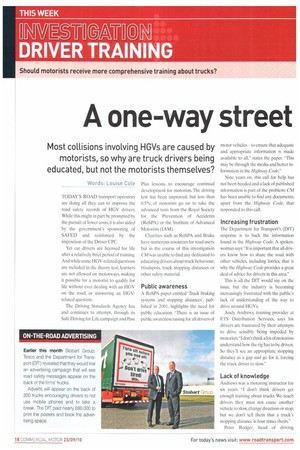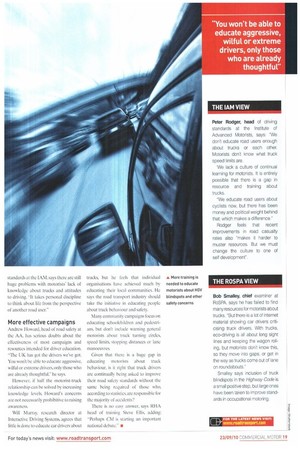A one-way street
Page 18

Page 19

If you've noticed an error in this article please click here to report it so we can fix it.
Most collisions involving HGVs are caused by motorists, so why are truck drivers being educated, but not the motorists themselves?
Words: Louise Cole
TODAY'S ROAD transport operators are doing all they can to improve the road safety records of HGV drivers. While this might in part be prompted by the pursuit of lower costs, it is also aided by the government's sponsoring of SAFED and reinforced by the imposition of the Driver CPC Yet car drivers are licensed for life after a relatively brief period of training. And while some HGV-related questions are included in the theory test, learners are not allowed on motorways, making it possible for a motorist to qualify for life without ever dealing with an HGV on the road, or answering an HGVrelated question.
The Driving Standards Agency has and continues to attempt, through its Safe Driving for Life campaign and Pass Plus lessons, to encourage continual development for motorists. The driving test has been improved, but less than 0.5% of motorists go on to take the advanced tests from the Royal Society for the Prevention of Accidents (RoSPA) or the Institute of Advanced Motorists (IAM).
Charities such as RoSPA and Brake have numerous resources for road users, but in the course of this investigation CM was unable to find any dedicated to educating drivers about truck behaviour, blindspots, truck stopping distances or other safety material.
Public awareness
A RoSPA paper entitled 'Truck braking systems and stopping distances', published in 2001, highlights the need for public education. "There is an issue of public awareness raising for all drivers of
motor vehicles — to ensure that adequate and appropriate information is made available to all," states the paper. "This may be through the media and better information in the Highway Code."
Nine years on, this call for help has not been heeded and a lack of published information is part of the problem: CM has been unable to find any documents, apart from the Highway Code, that responded to this call.
Increasing frustration
Hie Department for Transport's (DfT) response is to back the information found in the Highway Code. A spokeswoman says:"It is important that all drivers know how to share the road with other vehicles, including lorries, that is why the Highway Code provides a great deal of advice for drivers in this area."
This is all the EMT would say on the issue, but the industry is becoming increasingly frustrated with the public's lack of understanding of the way to drive around HGVs.
Andy Andrews, training provider at ETS Distribution Services, says his drivers are frustrated by their attempts to drive sensibly being impeded by motorists."I don't think a lot of motorists understand how the rig has to be driven. So they'll see an appropriate stopping distance as a gap and go for it, forcing the truck driver to slow."
Lack of knowledge
Andrews was a motoring instructor for six years. "I don't think drivers get enough training about trucks. We teach drivers they must not cause another vehicle to slow, change direction or stop, but we don't tell them that a truck's stopping distance is four times theirs," Peter Rodger, head of driving standards at the IAM. says there are still huge problems with motorists' lack of knowledge about trucks and attitudes to driving. "It takes personal discipline to think about life from the perspective of another road user."
More effective campaigns
Andrew Howard. head of road safety at the AA, has serious doubts about the effectiveness of most campaigns and resources intended for driver education. "The UK has got the drivers we've got. You won't be able to educate aggressive, wilful or extreme drivers, only those who are already thoughtful," he says.
However, if half the motorist-truck relationship can be solved by increasing knowledge levels. Howard's concerns are not necessarily prohibitive to raising awareness.
Will Murray, research director at Interactive Driving Systems, agrees that little is done to educate car drivers about trucks, but he feels that individual organisations have achieved much by educating their local communities He says the road transport industry should take the initiative in educating people about truck behaviour and safety Many community campaigns focus on educating schoolchildren and pedestrians, but don't include warning general motorists about truck turning circles, speed limits, stopping distances or lane manoeuvres.
Given that there is a huge gap in educating motorists about truck behaviour, is it light that truck drivers are continually being asked to improve their road safety standards without the same being required of those who. according to statistics. are responsible for the majority of accidents'?
There is no easy answer, says RHA head of training Steve Ellis adding: "Perhaps CM is starting an important national debate." •
































































































































